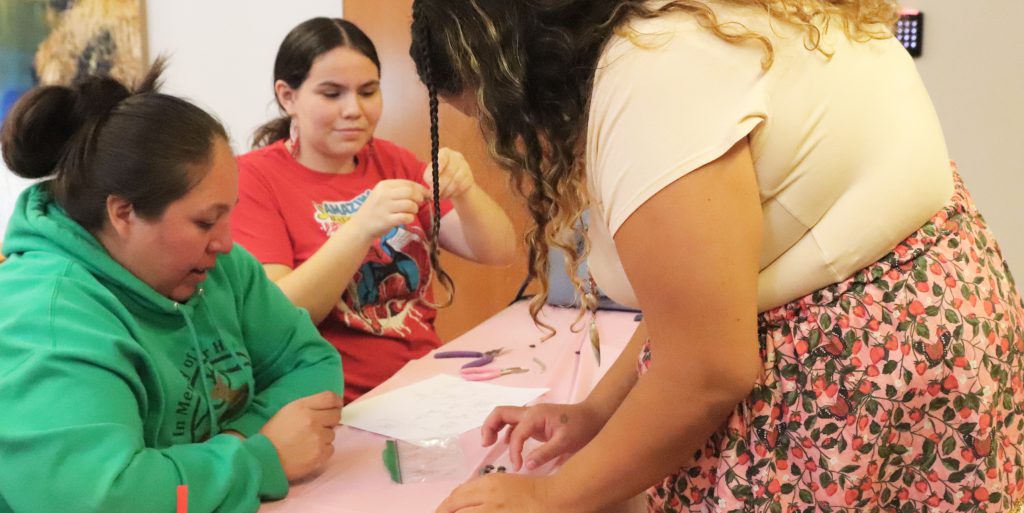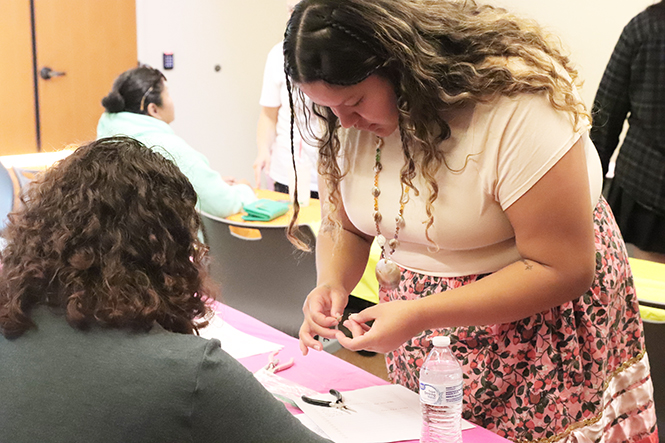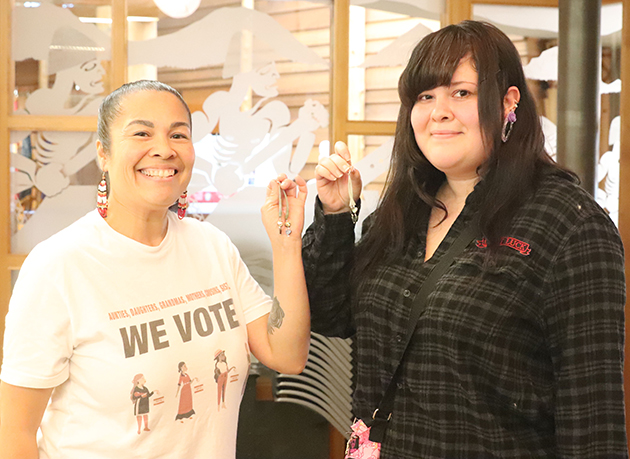
By Wade Sheldon, Tulalip News
Dentalium was once a symbol of wealth for the people of the Salish Sea. Often used as ornaments in clothing, headdresses, or even as currency by some tribes in the Northwest Coast of the United States and Canada, dentalium comes from scaphopods, a hollow-shelled mollusk. Its tusk-like shape and shiny white appearance made it highly prized. Today, dentalium holds cultural significance and is often crafted into jewelry.
Cultural bearer Santana Shopbell-Proehl and her husband, Nick Proehl, incorporated this material into a jewelry-making class they led. On Saturday, October 12, over 20 participants gathered at the Hibulb Cultural Center to learn how to create their own dentalium earrings. During the session, which lasted a couple of hours, attendees worked with the delicate material, creating unique jewelry pieces to take home.
Santana described how she became involved in teaching jewelry-making classes. She explained that her connection to the class began through her work as an artist in the community. “I recently started making dentalium earrings, and I’ve also done a lot of salmonberry, abalone work, and bracelets. I’ve had a couple of classes here already, so they had me on their list of artists, and that’s how I was invited.”

When discussing the concept behind her class, Santana reflected, “Honestly, it’s weird. I wanted to make something modern but with a story of Indigenousness—a modern touch. When I create pieces, sometimes I think, ‘Oh, that would look good,’ or, ‘Maybe this would look good.’ It’s a process of trial and error. I now look at some of my first pieces and think, ‘Oh no, I wouldn’t make that again.’ But as you grow as an artist, you start seeing and envisioning things differently.”
She explained that the class was designed to be both creative and accessible. “When I pieced this set together, I wanted to make something easy—a beautiful earring design that anyone could learn.”
Tulalip tribal member Aliana Diaz shared her experience attending the jewelry-making class. “It was terrific, and Santana’s detail-oriented. She helped us feel welcomed. I’ve never made Native jewelry before. It was my first time dealing with dentalium, and I found it was a little more delicate than I thought it would be, so it made it a little bit harder,”
She further expressed the importance of connecting with her cultural heritage. “Beadwork has been in our family—my aunties have done beadwork—and ever since I was a kid, I’ve been interested in it. Being able to connect with our culture is important to me, and for my daughter to connect with it as well.”

Gloria Warner, Diaz’s daughter and tribal member, spoke about the class. “One of the biggest reasons I wanted to return to the rez was more than just making earrings; I wanted to be around other Native people to heal that historical trauma. Art and culture are a huge part of that, and it’s been scientifically proven to help heal historical trauma.”
Diaz echoed Warner’s sentiments, adding, “We’re trying to fill the gap that our family has experienced with the loss of culture.”
As the class ended, participants proudly admired their handmade earrings, each piece showcasing a blend of creativity, culture, and connection.
Only two more arts/crafts Season of Healing events remain; on October 19, Jamie Sheldon will lead a cedar jewelry class, followed by a painting session with Monie Ordonia on October 26. Also, bonus carving classes with Ty Juvinel are every Thursday throughout October. For class times and pricing or to register, call (360) 716-2600 or visit online at info@hibulbculturalcenter.org.